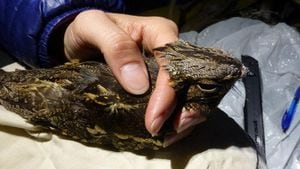Lovelorn Marcel the nightjar still without a mate after 600-mile tour of England
University of York researchers have been tracking the behaviour of the threatened birds.

Scientists following the antics of a lovelorn nightjar which unexpectedly travelled more than 600 miles across the UK in a quest to find a mate have renamed the bird Marcel, after the Love Island contestant.
The University of York researchers tracking the behaviour of the threatened birds on the Humberhead Peatlands, near Doncaster, were amazed to see how Bird 16840 went on an odyssey around the UK after failing to find a partner locally.
Dr Kathryn Arnold, senior lecturer in ecology from York’s Environment Department, said her team decided to call him Marcel after his GPS showed how he first flew south to Cambridgeshire, then over to Norfolk before heading to Milton Keynes, the Severn Valley and Birmingham.

He then headed home but has still not found his mate with only a few weeks of the breeding season still to go.
Marcel Somerville came fourth on the hit ITV2 show after finding love with Gabby Allen.
Dr Arnold said: “Last month, we were shocked when the satellite tracking data came back from Bird 16840 – or Marcel as we have nicknamed him, in honour of Love Island.
“After four days of searching and not finding a mate, Marcel then did a tour of England. In less than a week he flew over 600 miles.
“First, he flew south to Cambridgeshire, then up to Wells-next-the-Sea in Norfolk, before heading across to Milton Keynes, the Severn Valley in Shropshire and central Birmingham, before heading back to the Humberhead Peatlands. He made several stopovers but obviously never found a suitable female to start a family with.”
Dr Arnold said: “My colleague, Lucy Ryan, then caught him again less than 100m from where he originally started. We had no idea that he had been on such an adventure until we downloaded the GPS tag data.
“We checked and double-checked that there was no malfunction with the tag or error with the satellites – but the data is correct. After all that, he still hasn’t found a mate, but the breeding season still has another three weeks to go.”

She said the other 20 birds they had followed all stayed within a few miles of the peatlands during the breeding season.
The team are continuing their tracking in the hope that Marcel will find his match.
Nightjars, which breed in the UK on heathlands and feed on moths and flying beetles, have been in decline for many years and they are species of conservation concern.
York’s Environment Department fitted birds on the Humberhead Peatlands near Doncaster with miniature GPS tags so they can find out where they feed and nest.





